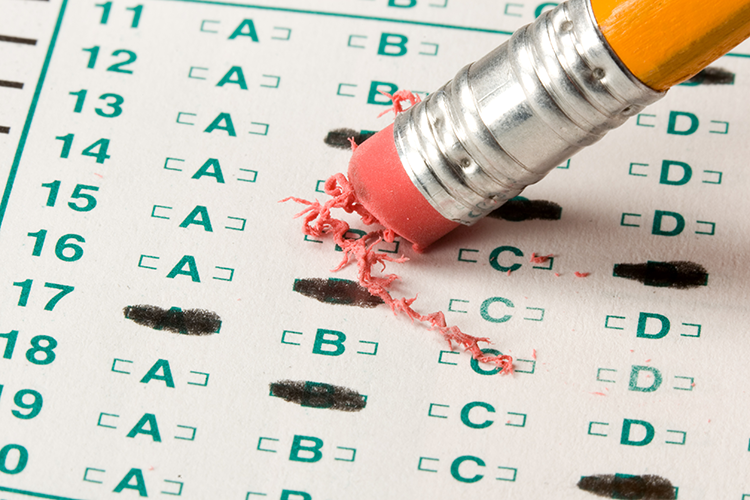Roberts’ reference to memos of Blackmun on Roe v. Wade raises questions about SCOTUS justices’ private papers

Image from Shutterstock.
The collected papers of late U.S. Supreme Court justices are typically of interest primarily to judicial biographers, legal researchers and a few journalists.
On Dec. 1, during oral arguments in one of the most consequential cases of the term, a new aficionado of the genre revealed himself: Chief Justice John G. Roberts Jr.
The court was hearing arguments in Dobbs v. Jackson Women’s Health Organization, about Mississippi’s law that bars most abortions after 15 weeks of pregnancy, well before the fetal viability point established as the line for legal abortions by the court’s landmark 1973 decision in Roe v. Wade. Roberts referred to the private papers of the late Justice Harry A. Blackmun, who wrote the court’s opinion in Roe.
“It’s an unfortunate source, but it’s there—in his papers, Justice Blackmun said that the viability line was—actually was dicta,” the chief justice told Scott G. Stewart, the Mississippi solicitor general. “And, presumably, he had some insight on the question.”
Later in the argument, Roberts referred to Blackmun’s papers again. “It’s like what Justice Blackmun said … when discussing among his colleagues—which is a good reason not to have papers out … that early—is that they don’t have to address the line-drawing at all in Roe,” the chief justice said.
Working papers
There was much to unpack in Roberts’ brief references to the private papers of a member of his court, which implicated the court’s own norms of behavior, the history of its most controversial modern case and the divergent decisions by justices about what to do with their papers.
And with the abortion case a subject of intense interest, more people than usual were paying attention, leading to some instant analysis of and strong reactions to the chief justice’s remarks.
“Justice Blackmun’s Papers?!” was the headline of a blog posting by Josh Blackman, a law professor at South Texas College of Law Houston. “Definitely an ‘unfortunate source’,” he wrote at Reason.com.
“The private papers of a justice! This is unforgivable, especially as Blackmun joined the court’s reaffirming of the viability line in [1992’s Planned Parenthood of Southeastern Pennsylvania v. Casey],” Georgia State University College of Law professor Eric J. Segall wrote at Dorf on Law.
Segall, a longtime advocate of greater transparency by the court, says in an interview that the justices have rarely, if ever, referred during oral arguments to the internal deliberations of their predecessors by citing justices’ papers.
“It was really surprising to me,” Segall says of the chief justice’s invocation of internal memos and papers reflecting a justice’s early-stage thinking about a difficult case.
“This was something written before the final product,” Segall says of the Blackmun memo. “The justices have to be able to communicate with each other and work out ideas.”
And the chief justice himself seemed to recognize that he was breaching a norm when he noted he was citing “an unfortunate source,” Segall says.
Then there was the chief justice’s characterization of Blackmun’s discussion of fetal viability.
Linda Greenhouse, the former longtime Supreme Court correspondent of The New York Times who now writes about the court as an opinion columnist for the paper, wrote on Dec. 3 that Roberts had “mischaracterized” a Nov. 21, 1972, memo in which Blackmun, who was then drafting the court’s opinion in Roe, referred to an “arbitrary” line for legal abortion.
Greenhouse wrote a 2005 book about the justice, Becoming Justice Blackmun, based largely on his vast and detailed collection of papers at the Library of Congress, which were opened to the public five years after his death in 1999. She noted in her column that Blackmun had been persuaded by internal court deliberations that fetal viability “has logical and biological justifications,” as the justice put it in a later memo.
“In other words, by the time the court issued the final opinion in January 1973, viability was not dicta but rather an essential element of the decision,” Greenhouse wrote in the column. “Chief Justice Roberts may not like viability … but he was flatly wrong to suggest that it was an unconsidered aspect of Roe v. Wade.”
The ‘early release’ of Marshall and Blackmun papers
Roberts’ comment later in the argument that there were good reasons for justices not to release their papers “that early” underscores that such decisions have been left to each member of the court.
No federal law governs the preservation of a justice’s papers the way a 1978 statute addresses presidential and White House records. Scholars say that few justices’ papers were preserved before the 20th century. Justice Louis D. Brandeis began donating some of his papers to the University of Louisville before he retired in 1939. But others from that era either restricted access or destroyed many of their papers, says Susan David deMaine, the law library director at Indiana University Mauer School of Law, who has written articles on the topic.
The subject attracted unusual attention in 1993, when the Library of Congress opened Justice Thurgood Marshall’s papers soon after his death that year. The collection included case files from as recently as two years earlier, when he retired from the bench. That prompted a letter of protest from then-Chief Justice William H. Rehnquist. The librarian of Congress refused to yield, saying he was following Marshall’s wishes. (Rehnquist even tried to cajole his colleagues to agree to withhold their papers for a set period of time, such as after all the colleagues with whom a justice had served had retired or died. Rehnquist dropped the idea when it did not get unanimous support.)
Blackmun’s papers, released in 2004, contained what many such collections do: early drafts of opinions, memos circulated among the justices about particular concerns in such opinions, law clerk bench memos and other papers from within the justice’s chambers. Blackmun’s collection was more thorough than others—he saved his notes from the justices’ private conferences, cert pool memos, notes passed along the bench during arguments, and even letters he received from schoolchildren.
Since the release of the Marshall and Blackmun papers, other justices have dictated more restrictive terms for the release of their papers. Rehnquist, who died in office in 2005, arranged for his papers to be donated to the Hoover Institution at Stanford University. They are restricted on a rolling basis, depending on when the colleagues with whom Rehnquist served die.
Justice David H. Souter, who retired in 2009, gifted his papers to the New Hampshire Historical Society but declared that they not be made public until 50 years after his death.
“That is so long as to be a virtually eternal lockdown,” says deMaine. “By the time they are opened, there won’t be a whole lot to learn from them.”
In 1977, the same federal commission whose recommendations led to the law governing White House documents called for Supreme Court justice’s private “working papers” (as opposed to their genuinely personal papers) be classified as public property. Kathryn A. Watts, a law professor at University of Washington School of Law, made a similar proposal in a 2013 paper.
In a forthcoming paper, deMaine calls for a federal grant program that would encourage donations of papers with shorter embargoes by offering money to the receiving institution to help process the collection.
DeMaine believes a 15-year embargo on public access would be just right.
“It would give the people who would be subject to the most scrutiny from the justice’s papers to get some distance,” she says. “But it’s not so long that the papers will have been relegated to the dustbin of history.”
Nancy S. Marder, a law professor at Chicago-Kent College of Law and a former law clerk to the late Justice John Paul Stevens, says any requirement that justices preserve their papers and release them within a set time period would be likely to have some unintended effects.
“Justices will just change their behavior accordingly,” she says. “Justices need to be able to talk to their law clerks and feel that those will remain confidential conversations.”
Still, she supports the release of papers after a reasonable interval of time.
As it happens, the next potentially revelatory papers are slated to come from the collection of Stevens, who retired in 2010 and died in 2019. CNN reported last month that the first batch of Stevens’ papers, covering the period from his arrival on the high court in 1975 through 2005, was scheduled for public release by the Library of Congress by 2020. But the transfer of the files from the court to the library has been slowed by the COVID-19 pandemic, CNN said.
Stevens’ papers could shed light on such major cases as Bush v. Gore, the 2000 decision that resolved the disputed presidential election of that year, CNN pointed out.
That is certainly possible if Stevens retained memos circulated among the justices. However, Marder says Stevens was not the note-taker or pack rat of internal memos that Blackmun was. He held most conversations about cases with his clerks orally rather than on paper.
“I have a feeling many people are going to be disappointed by his papers,” Marder says.



